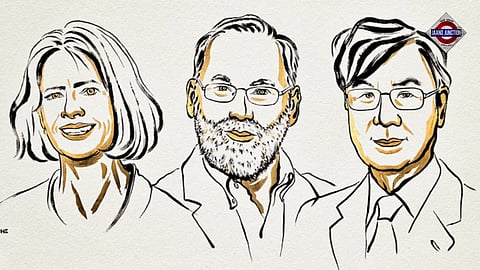

The Nobel Prize in Physiology or Medicine 2025 has been awarded to Mary E. Brunkow, Fred Ramsdell, and Shimon Sakaguchi for groundbreaking discoveries that explain how the body’s immune system is kept in check to prevent it from attacking its own organs.
Mary E. Brunkow (born 1961) earned her Ph.D. from Princeton University, USA, and currently serves as Senior Program Manager at the Institute for Systems Biology in Seattle. Fred Ramsdell (born 1960) received his Ph.D. in 1987 from the University of California, Los Angeles, and is now Scientific Advisor at Sonoma Biotherapeutics, San Francisco.
Shimon Sakaguchi (born 1951) obtained his M.D. in 1976 and Ph.D. in 1983 from Kyoto University, Japan, and is Distinguished Professor at the Immunology Frontier Research Center, Osaka University.
Their pioneering work on peripheral immune tolerance revealed how a special class of immune cells, known as regulatory T cells, act as guardians against autoimmune disease.
Every day, the immune system defends us from thousands of invading microbes. But many pathogens mimic human cells to evade detection, making it vital for the immune system to distinguish between foreign threats and the body’s own tissues.
The laureates’ work answered this long-standing question by uncovering the mechanisms behind peripheral tolerance, the immune system’s ability to avoid self-harm.
Shimon Sakaguchi paved the way in 1995 when he challenged the prevailing view that immune tolerance was solely maintained by eliminating harmful immune cells in the thymus, a process called central tolerance. His research showed the immune system was more complex, identifying an entirely new type of immune cell—regulatory T cells—that shield the body from autoimmune disorders.
In 2001, Mary Brunkow and Fred Ramsdell advanced this field through genetic research. While studying a mouse strain prone to autoimmune disease, they discovered a mutation in a gene they named Foxp3.
This mutation disabled the immune system’s regulatory controls, leading to severe illness. Crucially, they confirmed that mutations in the human equivalent of Foxp3 cause a rare but serious autoimmune condition known as IPEX syndrome.
Two years later, Sakaguchi connected the dots, proving that the Foxp3 gene orchestrates the development of the regulatory T cells he had identified earlier. These cells act as immune monitors, ensuring that defensive responses target genuine threats while tolerating the body’s own tissues.
“Their discoveries have been decisive for our understanding of why we do not all develop serious autoimmune diseases,” said Olle Kämpe, chair of the Nobel Committee.
Beyond transforming immunology, these findings have opened new frontiers for medical treatments. The concept of peripheral tolerance now underpins emerging therapies for autoimmune diseases, cancer, and organ transplantation. Several Foxp3-based therapies are already in clinical trials, with hopes of improving patient outcomes and enabling more successful transplants.
The 2025 Nobel Prize in Medicine celebrates three scientists whose collaborative breakthroughs have reshaped the fight against immune-related illnesses, offering hope for millions affected by autoimmune and inflammatory diseases worldwide.
